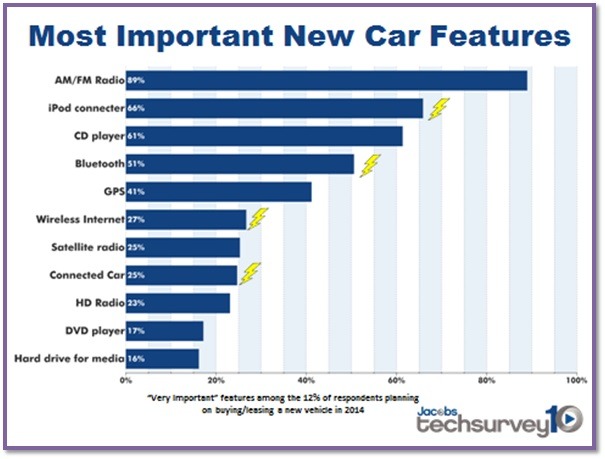A big story in both radio and automotive circles this week surrounds GM’s announcement that they’re equipping more than 30 vehicles in their 2015 lineup with 4G LTE connectivity. This is the biggest OEM commitment to WiFi and includes entry level vehicles like the Chevy Malibu.
Of course, GM vehicles were the first to be “connected” with the original OnStar service that has been expanded substantially over the years.
Consumers are demanding it, and the automakers are continuing to make it easier and more seamless to allow their drivers (and their passengers) to connect their hardware and software while they drive. As many as seven devices can be connected to any of these equipped GM vehicles, so there are major family implications here.
Of course, this plan comes with a cost, and it’s weaved into existing OnStar subscriptions, as well as AT&T customers. But you can see the trajectory. More and more consumers are demanding more connectivity in vehicles.
It’s important for radio to understand the mindset of the OEMs and Tier 1 suppliers. It’s why we do DASH, it’s why we go to CES, and it’s why we continue to conduct research in this space. The car is radio’s lifeline, so having a firm grasp of how they perceive the in-car infotainment ecosphere is key for radio. Back in January at CES, we caught up with GM’s Lead Connected Customer Specialist Ben Taft who walked me through the in’s and out’s of the company’s WiFi initiative. In this short video, we’ll take you backstage, and you’ll hear Taft paint the WiFi picture, and you’ll hear why GM is all in, from their entry level vehicles to their top of the line Corvette (the car in which I got this demo):
Email viewers, please click here for the video
Much of this is being driven by consumers themselves. In Techsurvey10, we asked prospective new car buyers (12% of the total sample) about the most important features they want in their next vehicle. And as you can see, once you get beyond the ubiquitous AM/FM radio, the desire for connectivity – in many forms – continues to grow. The “lightning bolt” icons tell a rapidly changing in new vehicles feature demand:
All this continues to serve as a reminder that radio needs to ensure that its streams are competitive, robust, and reliable. It’s also more reinforcement for a mobile strategy that makes your brand available on every device the consumer carries around – from mobile apps to your website to your presence and interactivity in social media.
And in the bigger picture, the in-car onus is firmly on radio’s programmers and strategists to craft stations that stand out in increasingly crowded “center stacks.” The choices are becoming infinite.
We’re competing with everybody.
Register for DASH, the conference that brings the automotive & radio industries together | Detroit, October 15-16 | www.dashconference.com
- Media And Technology In 2025: Believe It Or Not! - April 18, 2025
- In Radio, You Just Never Know - April 17, 2025
- The Secret To Making A Great Podcast (And Great Radio) - April 16, 2025





Leave a Reply